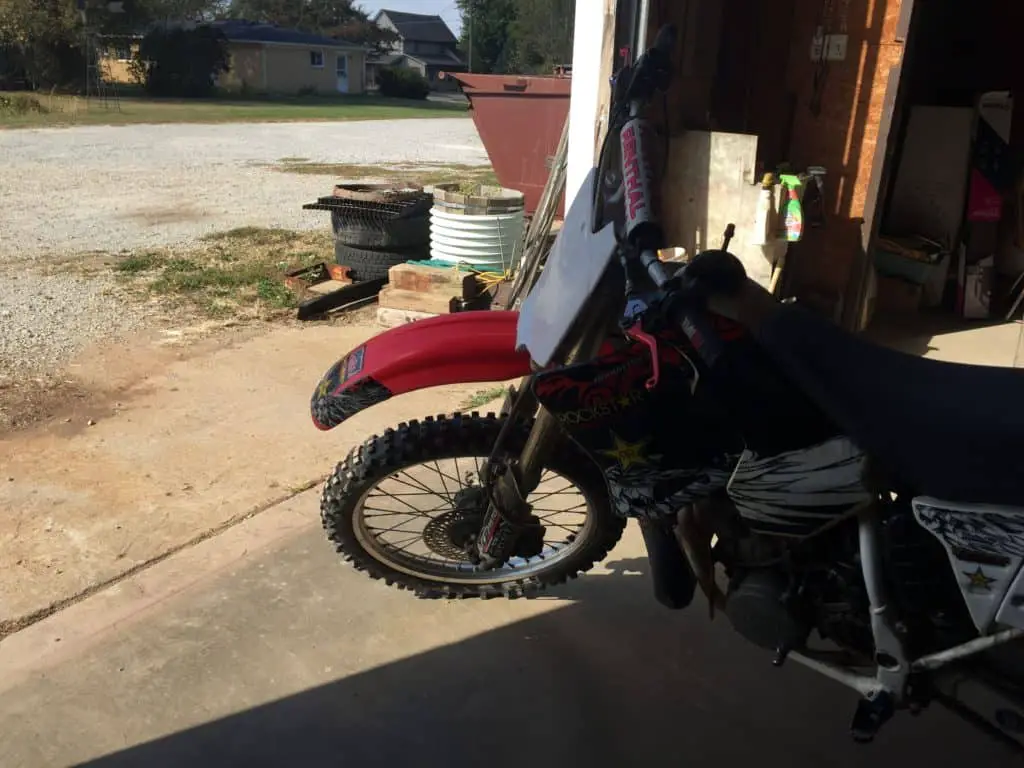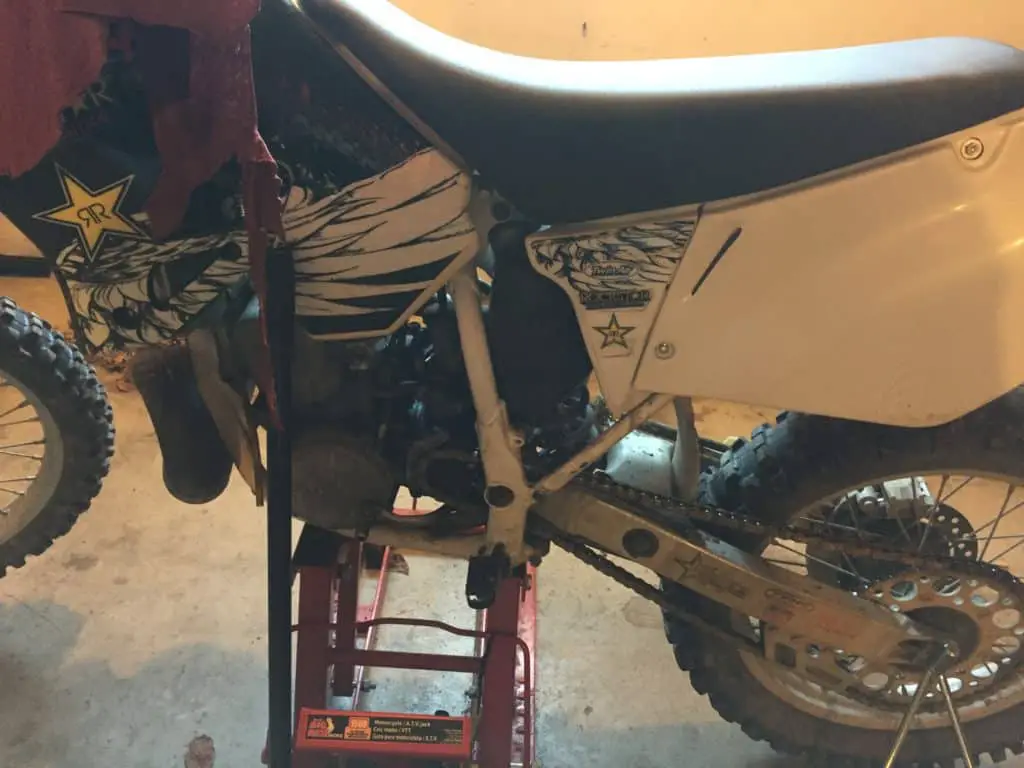The other day I was online reading an article comparing a two-stroke dirt bike to a four-stroke dirt bike. One comment pointed to the fact we do not see manufactures making two-stroke dirt bikes any more.
I wanted to learn why and here is what I found out. The two most common reasons attributable to manufacturers not making two-stroke dirt bikes are emissions and advancements in technology. A third and less discussed reason was a changing marketplace.

To understand the reality of the reduction in two-stroke dirt bikes, one needs to start with knowing these reasons are not accurate. The truth starts with street two-strokes disappearing a few decades ago.
Street Two-Strokes Disappeared In the 1960s
This is not the first time we’ve seen this debate come up. Back in the 60s and early 70s 2-stroke motorcycles were very popular. In fact, they were some of the most powerful motorcycles of the day.
Then as the early 70s came we saw the early rise of the word smog. The gas crunch came. Fuel efficiency became the name of the game, and reducing overall emissions in automobiles was the goal.
The bad part is the two-stroke motorcycle ridden on the street was making the four stroke motorcycle look very slow. Almost like they were walking. Two stroke motorcycles produce almost 30% more power per cc than a conventional four-stroke.
The increase in power did not come without a tradeoff. As I mentioned earlier, the word smog and fuel efficiency became the name of the game.
You could look at cities such as Los Angeles and see the effect of smog and other pollutants. This did not sit well with the national or state EPA’s which started creating pollution standards for vehicles. Now imagine being a motorcycle rider in the day, sitting in front of the EPA officer who is seeing your motorcycle spew two-stroke smoke.
Can you imagine this person running as quickly as they could from their office down the steps at the front of a capitol to give you a stern lecture on why riding that motorcycle is dangerous not only for yourself but the environment?
As the 70s rolled on street 2-stroke motorcycles faded off into the sunset. The ones that remain today are highly coveted and have become collector’s items. It’s not uncommon for these motorcycles to achieve a high price at auction.
I cannot imagine a world today where 2-strokes regularly ridden on the streets.
Technology Killing the Two-Stroke Dirt Bike
Well, one could put a large blame on emissions as the driving cause and seeing this two-stroke motorcycle go away. The reality is such that technology would’ve had a large impact on driving out the two-cycle engine.
In the same way the cars significantly improved with technology over the years, the same illustration happened with motorcycles. What is interesting though is that it appears motorcycles lag after cars for a few years. Here is an article about cruise control on motorcycles that shows my point.
This is not much of a surprise considering differences in the nature of traveling between an automobile and riding on two wheels.
The basic two-cycle engine has changed little over the years. For example, go back to the dirt bikes of the 1960s through the late 90s and you’ll see the biggest change coming in two forms.
The first it’s becoming water cooled. The liquid cooled engine allowed it to make more horsepower. Not that air-cooled engines are not powerful, rather this illustrates the point of improved technology.
We can also point to adding things like power valves, shape of the cylinder heads, and so on as other technological advancements in the two-stroke engine.

But the reality is a four-stroke engine achieved and made up much ground when compared to the two-stroke. It would have eventually become a regular contender against the two-stroke. That is not a discussion we are here to have today.
A Big Advantage for the 4-Stroke Dirt Bike
Continuing along the technological spectrum, one enormous advantage to a four stroke dirt bike is the duration of time between rebuilding the top end of the motor.
Estimates run anywhere from 20% to four times longer in between rebuilding the top end of a motor on a four-stroke. Two-stroke motorcyclists will tell you rebuilding a two-stroke engine is cheaper than rebuilding a four-stroke engine. While this may be true it is also shortsighted if you are on the motorcycle for any amount of time. The continued cost of rebuilding will eventually outpace the short-term savings.
Applying the simple math above and you’ll see the longer you own a four stroke motorcycle the more economical it may be. A good part of the cost and rebuilding an engine is the cost of labor.
So if you’re willing to invest some time learning how to disassemble a four-stroke engine, parts may be more expensive but not disproportionately over the life of the motorcycle.
We need to mention the skill set needed to rebuild a four-stroke engine is greater than a two-stroke engine because of the number of additional parts. Consider it a difference between putting together a 100 piece puzzle and a 500 piece puzzle. It’ll take more patients and time.
Emissions Killing The Two-Stroke Dirt Bike
As we already talked about earlier many people attribute the EPA is the killer of the two stroke dirt bike. Technological advancement was also a key driver in helping get rid of the two-stroke engine.
The reality is, the EPA did not kill the two-stroke dirt bike. The argument states the two-stroke died off as the EPA started making standards for the environment. In fact, automobiles are the primary driver. Street motorcycles get caught in the crossfire. And as it stands we don’t have any two-stroke street bike manufacturers today.
As the EPA rolled out these new standards, it did not concerned itself with dirt bikes.
The EPA standards for off-road vehicles did not come until much later.
The AMA had its hand in killing off the 2-stroke dirt bike. This is about the time he saw the four-stroke engine emerge in things like Supercross and motocross. This timeline started around the early 2000s (more on this in a moment.)
The standards started becoming a factor for dirt bikes; it was much easier for manufacturers to work with four-stroke engines to become compliant to the new standards. The things such as valve timing, fuel injection, and such was much easier to work with versus pouring large amounts of money into an engine model that had a large uphill battle to meet the new standards.
Dirt Bike Emissions Balancing Act
As a fan of two-stroke motorcycles, it saddened me to see them go away. The last two-stroke I had before I stopped riding dirt bikes for two decades was my 92 RM 125.
As a person who really loves trail riding and respects the environment, I can also appreciate having standards in place to preserve and protect those areas where we enjoy riding.
I will say I find this topic interesting. Some articles I’ve researched say that the modern EPA does not concern itself with dirt bikes and off-road vehicles. I would point out we do we would have things like decibel levels for off-road vehicles which really originates with state DNR regulations
AMA Killing The 2-Stroke Dirt Bike
AME also had his hand in killing off the two stroke dirt bike. Specifically, as the four-stroke engine came online and started becoming popular competing with the two-stroke, the AMA was forced to address power and differences between the two engines.
In 1998 the AMA produced a ruling that said 450 stroke engines could compete with 250 two-stroke engines. If you remember, I mentioned earlier that two strokes produce roughly 30% more power per cc than a four stroke.
Fast forward in time with the improved technological advancement with four strokes and this ruling handed down from the AMA, professional writers started moving over to the 450 4-stroke.
Is it much of a surprise? The old two-stroke engine couldn’t compete with the much larger displacement with the technological advance of the 450s.
Hedging Your Bets
It appears a few manufactures did not get the memo that two strokes are extinct. LOL. Specifically, Husqvarna and KTM still produce two strokes along with a few others. The vast majority of these dirt bikes are not motocross or Supercross dirt bikes but enduro focus.
We should also note they make the comparable for stroke motorcycles.

KTM and Husqvarna for all intents and purposes are the same motorcycle and manufactured most times on the same line.
Basically, what they did was start applying the same technological advancements from 4-strokes to the two-stroke engine. So now we see things such as electronic fuel injection and computers on the bike.
So there are two things if you’re a two-stroke fan.
1. Buying a dirt bike and be willing to work on it and rebuild the engine more frequently than the newer bike.
2. Buy a newer bike with modern components. Obviously you’ll be paying much more for the second option.
Here are some more common two-stroke dirt bikes manufactured today.
| BETA XTRAINER |
| GASGAS EC300/EC250 |
| GASGAS EC RANGER 300 |
| HUSQVARNA TC250 MOTOCROSS |
| KTM 250SX MOTOCROSS |
| HUSQVARNA TX300 |
| HUSQVARNA TE300i/TE250i |
| KTM 300XC-W/250XC-W TPI |
| SHERCO SE300/SE250 RACING |
| YAMAHA YZ250 |
| YAMAHA YZ250X |
| BETA 200RR/125RR |
Now stop reading and go ride that 20-stroke. Rock and Roll!
